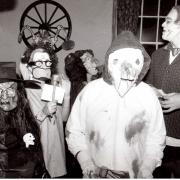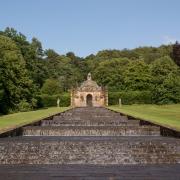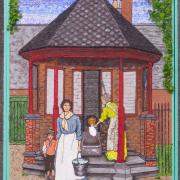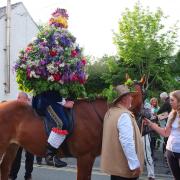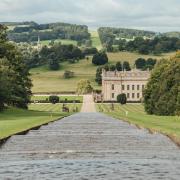The Green Man: a benign chaperone who halts the traffic in order to guide us safely across the road.
Derbyshire-based designer David Mellor was invited to overhaul the UK’s traffic light system in 1965 but did not deviate from this universally understood symbol; a set of Mellor-designed lights move continuously through their colour cycles in an incongruous woodland setting outside the David Mellor Design Centre in Hathersage.
But that is not the Green Man under scrutiny in this month’s feature.
The Green Man is, unsurprisingly, a male figure, who appears as a synthesis of human and plant, usually having a human-like face with foliage emerging in the form of hair and a beard, or sprouting from his mouth or nostrils.
He is understood to symbolise the return of spring, when the land becomes fertile again and vegetation and crops begin to grow following the long, dark, barren, cold months of winter.
Whilst representations of the Green Man appear carved and painted in artworks dating from around the 12th century onwards, his identity is more of a modern construction.
His characterisation as a pagan fertility figure and the embracing of the name ‘Green Man’ stem largely from an article penned by Lady Raglan for the journal Folklore in 1939 - before this article, these figures were more likely to be termed ‘foliate heads’ by art historians.
Raglan was writing during that romantic period following the publication in 1890 of The Golden Bough by Sir James George Frazer where whenever anyone donned a funny costume or performed a ritual dance on a set day of the year, it was viewed as evidence of survival of an ancient pagan fertility rite.
From the mid-20th century onwards, folklorists became a little more rigorous in their thinking.
Raglan’s hypothesis struck a chord with the general public, however. One place where the Green Man pops up regularly is within the fabric of churches.
Geoffrey R. Sharpe in his Historic English churches - a Guide to their Construction, Design and Features (2011) embraces the Raglan line, seeing their presence as a diplomatic move by the Christian church to incorporate familiar imagery from the earlier nature-worshipping religions:
‘The early Christian missionaries recognised the important role that pagan shrines and symbols could play in the promotion of Christianity, and took great care not to alienate the pagan communities through force or undue pressure [and began] either adapting or incorporating pagan icons into the practices of the early Church,’ he writes.
‘This is why so many pagan symbols continued to appear [in churches] until the time of the Tudors... A good example is the Green Man, which originated as a representation of the power of nature and the seasons and is now a sign of Easter and the Resurrection’.

A trio of Green Men are found at the Church of St John the Baptist, Tideswell, the so-called ‘Cathedral of the Peak’: one lurking rather subtly on the oak main door to the church, as well as two depictions inside, facing each other on either side of the choir stalls.
A further example can be found underneath the porch roof on the church of St James, Brassington, and another at St Peter & St Paul Church, Old Brampton.
The Green Man also appears carved in wood inside the churches of St John the Baptist at Ault Hucknall, All Saints at Bakewell, and on a beam over the West Window at All Saints, Wingerworth (in their guidebook, the church term him a ‘Jack O’ The Green’).

Given that his whole identity is bound up in nature, we may imagine the Green Man to be more at home in a rural setting, however he is also to be found in the heart of the city on either side of the main West Door to Derby Cathedral, looking down on the townsfolk who pass by daily, the majority of whom probably never notice him.
Of course, we love a bit of nature veneration utilising flora here in Derbyshire: the annual well dressings staged across the county during the summer months, where pictures are constructed using natural materials pressed into a clay-filled board and sited by a well or spring in thanks for the essential gift of water, are a justly famous tradition associated with our area.
This custom is another phenomenon whose origins have been lost in the mists of time, but which is generally assumed (in the absence of any documented evidence) to be an ancient pagan tradition which has survived over the centuries and embraced by the Christian church, with local vicars now performing blessing ceremonies at the well dressings when they first go up.

This led to controversy erupting in Eyam in 2006 when the Green Man was chosen for the design of the Town End Well.
The Rector of Eyam at the time, Reverend Andrew Montgomerie, blessed the village’s other two designs as normal, but felt unable to perform the ceremony for the Green Man design on principle.
He told the Derbyshire Times: ‘To me this is a pagan symbol. As a Christian I see it as an inappropriate subject matter and I cannot be expected to bless it – I can't simply brush my beliefs under the carpet to keep people happy’.
One village resident remembers villagers satirically fashioning Green Man costumes by way of response for the Wakes Week fancy dress parade marking the end of the well dressing week.
An earlier controversy had occurred at the well dressing village of Youlgrave. In 1979 to mark the Derbyshire Festival and 150th anniversary of the village’s piped water supply that year, the famous artist John Piper was invited to create a design for the well dressing at the Fountain.

He devised an image of the Green Man. On this occasion the result was deemed an artistic flop, rather than being ideologically contentious.
Most well dressing designers rise through the ranks, having first worked as part of the team making a well dressing themselves so have an ingrained knowledge of what designs will and won’t work; Piper, who was parachuted into the village, did not have this grounding and hence his vision proved difficult to realise in flower petals.
Ultimately, getting a star name involved was thought by many in the village to be an unsuccessful experiment.
Despite these controversies, the Green Man has proved an endearing inspiration for well dressing designers, appearing as the theme for the well dressings at Dore in 2013 and Cressbrook in 2016.
The Green Man also appeared in 2015 spewing out water from his mouth in a design for the Higher Buxton Well commemorating 175 years of a piped water supply to the town, which is what first prompted the well dressing festival here.

You’re never too far from the Green Man’s presence in Buxton, it would seem. The New Inn, across the road from the well, has as its pub sign a face resembling the Green Man incorporating grapes and vine leaves, and further down the hill behind the town's museum can be found the independent Green Man Gallery, selling the work of local artists.
Inside the museum itself, a sculpture of the Green Man's face invites visitors to post coins into his mouth to go towards the upkeep of the museum with the motto:
I am the Green Man
from an age long passed
Feed me whatever you can
so the museum may last
At Ashbourne, the Green Man lends his name to an inn, a prominent building on the town’s high street.
It opened in the 1750s; James Boswell stayed here in 1777 during a visit to Ashbourne with his muse Dr Johnson, rating it ‘very good’.
The inn played a prominent role in the town’s cultural fabric as it was here that the pre-match meal before the annual Shrovetide Football match was held and the boards recording the turner-uppers and goalers were kept; after the pub temporarily closed in 2012 these were removed to the town’s library and the meal now takes place in the leisure centre. Another pub named after the Green Man is located at Willington.
The Green Man can also be found at Winster, carved into the stone gateposts of the Dower House, lending the building its alternative name, ‘Green Gates’.
Whilst the purpose of the Green Man, who crops up across Derbyshire (and beyond, throughout Europe), may ultimately remain a mystery to us, his legacy endures and still speaks to us in the modern era.
As the recently published walking guide Weird Walk: Wanderings and Wonderings Through the British Ritual Year notes, ‘In the twenty-first century, the Green Man is very much a vegetation spirit, a guardian of the natural world who strikes a chord with us at a time of environmental crisis. He is beloved of many contemporary pagans for precisely this reason, their traditions being committed to living in harmony with the natural world’.






